Viviene Westwood, 1980-89
Westwood in the Press
Westwood and McLaren launched World’s End in 1980, the same year that The Face first went to press. The Face and other alternative publications, such as i-D, were highly influential magazines that covered fashion, music, and nightlife. Their editorials covered World’s End extensively, and contributed to the brand’s reputation by dressing musicians and adolescent models in World’s End attire.
As the decade progressed, Westwood’s solo work piqued the interest of international fashion editors. Her newly sophisticated designs emphasized feminine curves. The media responded by styling her clothing with professional models: in 1989, a Westwood design, worn by supermodel Tatjana Patitz, was featured on the cover of British Vogue. Westwood was now established within the fashion industry, and in 1990 she was named British Designer of the Year.
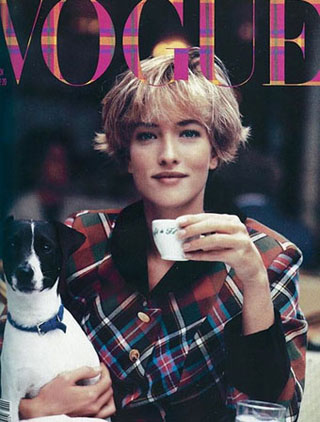
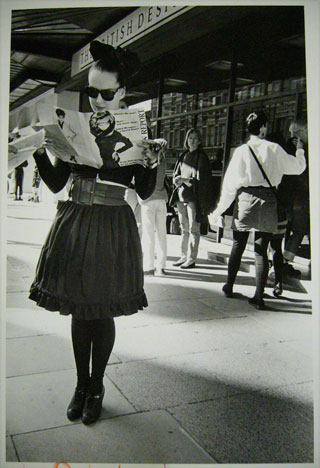
Nina Hyde
Model dressed in clothing from the Harris Tweed collection
Original print 1986
From the Nina Hyde Collection, US.NNFIT.SC.209.10.8
Fashion Institute of Technology|SUNY, FIT Library Dept. of Special Collections and FIT Archives
<---Tear sheet
Model Tatjana Patitz wearing a suit from the Time Machine collection
Photograph by Peter Lindbergh
British Vogue, November 1989
Westwood on the Runway
Early World’s End designs focused on drapery and layering, and could be worn by both women and men. References to historical fashion, street art, and world dress were combined with unlikely materials such as Velcro, sport fabrics, and rubber. Innovative cutting and styling resulted in asymmetrical designs that alternately clung to and hung away from the body.
Early World’s End designs focused on drapery and layering, and could be worn by both women and men. References to historical fashion, street art, and world dress were combined with unlikely materials such as Velcro, sport fabrics, and rubber. Innovative cutting and styling resulted in asymmetrical designs that alternately clung to and hung away from the body.
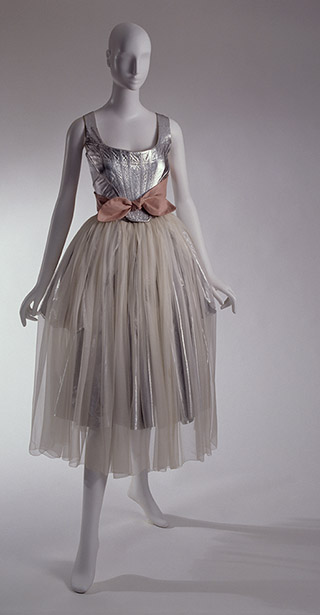
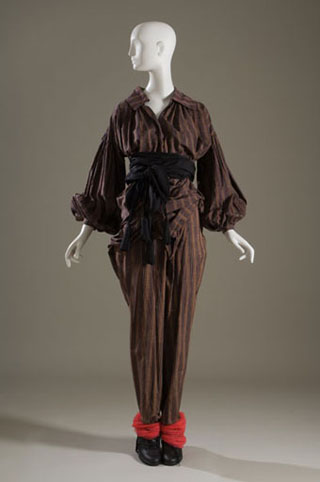
World’s End
(Malcolm McLaren and Vivienne Westwood)
Ensemble: tunic, trousers, and sash
Cotton
Pirates collection
Autumn 1981-82, England
The Museum at FIT, 87.52.5
Gift of Barbara Hodes
<--- Vivienne Westwood
"Statue of Liberty" ensemble
Leather, synthetic lamé, silk tulle
Time Machine collection
Autumn 1988, England
The Museum at FIT, P89.60.1
Museum purchase
Westwood In the Streets and On TV
Malcolm McLaren dressed the members of his pop group, Bow Wow Wow, almost exclusively in World’s End designs. The World’s End look appealed in particular to the image-conscious New Romantics, a subcultural group that emerged in reaction to the abrasiveness of Punk. They were drawn to the imaginative reinterpretations of historic dress that characterized World’s End style.
With the launch of MTV in 1982, World’s End clothing reached a wider audience through its visibility in music videos. McLaren’s interest in hip-hop culture influenced World’s End style, and graffiti prints by artist Keith Haring were incorporated into the designs.
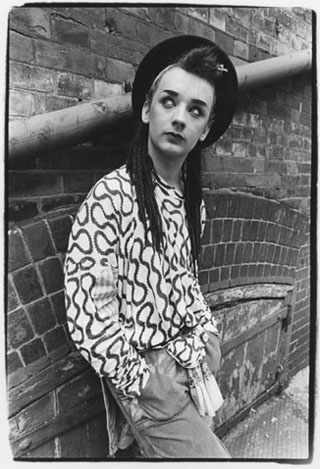
Westwood introduced elements of street style into her solo collections of the 1980s. She considered tattoos to be fashionable accessories, and created peek-a-boo clothing that allowed body art to be on display. The body was no longer hidden under layers of draped fabric. Westwood’s designs revealed the stylish,
toned physique that became the decade’s ideal.
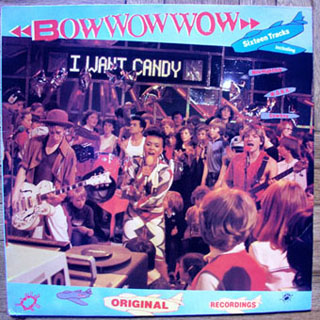
Bow Wow Wow
Record jacket
Sixteen Original Recordings
Design by Neil Matthews
Cardboard
1982, Canada
Harvest/EMI Records Limited
Courtesy Miriam Murphy
<---Laura Levine
Boy George, London, 1982
Black and white photograph
Courtesy of the artist © Laura Levine